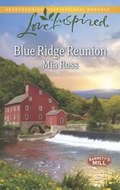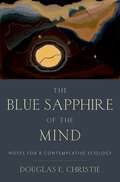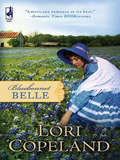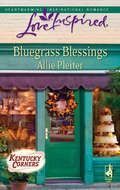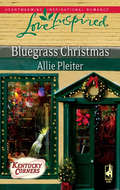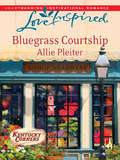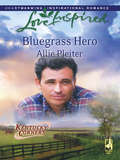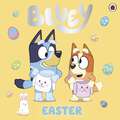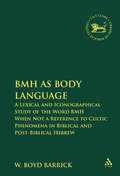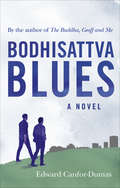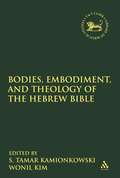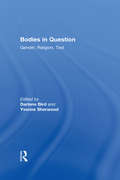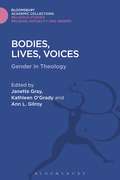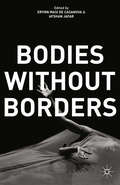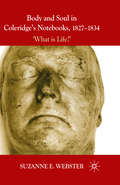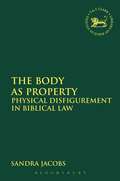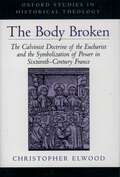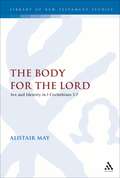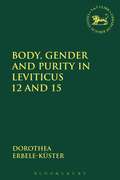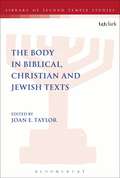- Table View
- List View
Blue Ridge Reunion: The Amish Nanny Blue Ridge Reunion Lone Star Hero (Barrett's Mill #1)
by Mia RossBuilding A New Start
The Blue Sapphire of the Mind: Notes for a Contemplative Ecology
by Douglas E. Christie"There are no unsacred places," the poet Wendell Berry has written. "There are only sacred places and desecrated places." What might it mean to behold the world with such depth and feeling that it is no longer possible to imagine it as something separate from ourselves, or to live without regard for its well-being? To understand the work of seeing things as an utterly involving moral and spiritual act? Such questions have long occupied the center of contemplative spiritual traditions. In The Blue Sapphire of the Mind, Douglas E. Christie proposes a distinctively contemplative approach to ecological thought and practice that can help restore our sense of the earth as a sacred place. Drawing on the insights of the early Christian monastics as well as the ecological writings of Henry David Thoreau, Aldo Leopold, Annie Dillard, and many others, Christie argues that, at the most basic level, it is the quality of our attention to the natural world that must change if we are to learn how to live in a sustainable relationship with other living organisms and with one another. He notes that in this uniquely challenging historical moment, there is a deep and pervasive hunger for a less fragmented and more integrated way of apprehending and inhabiting the living world--and for a way of responding to the ecological crisis that expresses our deepest moral and spiritual values. Christie explores how the wisdom of ancient and modern contemplative traditions can inspire both an honest reckoning with the destructive patterns of thought and behavior that have contributed so much to our current crisis, and a greater sense of care and responsibility for all living beings. These traditions can help us cultivate the simple, spacious awareness of the enduring beauty and wholeness of the natural world that will be necessary if we are to live with greater purpose and meaning, and with less harm, to our planet.
Bluegrass Blessings (Kentucky Corners #3)
by Allie PleiterEveryone in Middleburg, Kentucky, lines up for baker Dinah Hopkins's cinnamon rolls. Everyone except her handsome new landlord, Cameron Rollings. The jaded city man doesn't like anything about small-town life–from the fresh air to her fresh-baked snickerdoodles. And he clearly considers Dinah as quirky as her eccentric oven.
Bluegrass Christmas (Kentucky Corners #4)
by Allie PleiterAn Old-Fashioned Christmas That's what led new believer Mary Thorpe to start over in quaint Middleburg, Kentucky. As director of the church's Christmas pageant, Mary's job is to bring the townspeople together, to remind them what the season is really about.
Bluegrass Courtship (Kentucky Corners #2)
by Allie PleiterThe celebrity host of TV's Missionnovation, Drew Downing is comfortable with his fame. He's become accustomed to the cheering, star-struck townfolk that usually welcome him as he renovates churches countrywide. Usually. Then he and his crew set up in tiny Middleburg, Kentucky, to rebuild the church's storm-damaged preschool.
Bluegrass Hero (Kentucky Corners #1)
by Allie PleiterDust-covered men who smell like horses are the norm at Gil Sorrent's farm.
Bluey: Easter (Bluey)
by BlueyCelebrate Easter with Bluey!It's Easter and Bingo is worried the Easter bunny has forgotten about her and Bluey like last year. But when they wake up to a series of clues, Bluey and Bingo are led on an exciting Easter egg treasure hunt around the house!Join Bluey and Bingo on this fun adventure around the Heelers' home.Want more Bluey? Also available:Bluey: Fun and Games Colouring BookBluey: Meet Bluey! Sticker Activity BookBluey: Bluey and Friends Sticker Activity Book
BMH as Body Language: A Lexical and Iconographical Study of the Word BMH When Not a Reference to Cultic Phenomena in Biblical and Post-Biblical Hebrew (The Library of Hebrew Bible/Old Testament Studies)
by W. Boyd BarrickIt is customarily assumed that the Hebrew word BMH denotes a "high place," first a topographical elevation and derivatively a cult place elevated either by location or construction. This book offers a fresh, systematic, and comprehensive examination of the word in those biblical and post-biblical passages where it supposedly carries its primary topographical sense. Although the word is used in this way in only a handful of its attestations, they are sufficiently numerous and contextually diverse to yield sound systematic, rather than ad hoc, conclusions as to its semantic content. Special attention is paid to its likely Semitic and unlikely Greek cognates, pertinent literary, compositional, and text-critical matters, and the ideological and iconographical ambiance of each occurrence.This study concludes that the non-cultic word BMH is actually *bomet, carrying primarily (if not always) an anatomical sense approximate to English "back," sometimes expanded to the "body" itself. The phrase bmty->rs (Amos 4:13, Micah 1:3, and CAT 1.4 VII 34; also Deut. 32:13a, Isa. 58:14ab-ba, and Sir. 46:9b) derives from the international mythic imagery of the Storm-God: it refers originally to the "mythological mountains," conceptualized anthropomorphically, which the god surmounts in theophany, symbolically expressing his cosmic victory and sovereignty. There is no instance where this word (even 2 Sam. 1:19a and 1:25b) is unequivocally a topographical reference. The implications of these findings for identifying the bamah-sanctuary are briefly considered.
Bobby Bains Plays a Blinder
by null Bali RaiA young Sikh footballer reaches out across the generational divide to help a lonely old man in an uplifting story from acclaimed author Bali Rai. When he spots a lonely old man watching his football games in the park, and then sees him again eating at the local gurdwara kitchen, Bobby wants to help. At first the man doesn’t seem very friendly and he doesn’t want to take part in the local walking football league for older people that Bobby tells him about. But when Bobby eventually changes his mind, it turns out that the man is a talented former professional footballer who has recently been widowed, and Bobby’s invitation opens up a rewarding new opportunity for him to make connections in his local community.
Bodhisattva Blues: A Novel
by Edward Canfor-DumasEd is stuck in a rut - his part-time 'career' is going nowhere, his love life's a joke and his wallet's always empty.The thing about a rut, though, is at least you know where you are.So when Ed runs into an old acquaintance and is sucked into a drama of street crime and high-stakes property dealings, he turns to the principles that once served him well. Except - he's not sure if he can still trust them, especially as his Buddhist practice is a bit on the rusty side...Written by Edward Canfor-Dumas, award-winning screen writer and novelist, this is an urban story with a twist and a wry appreciation of the challenges we face every day - whether we're muddling by, or, like Ed, suffering from a severe case of the bodhisattva blues...A book for everyone who's ever wondered whether enlightenment really is compatible with the daily commute.
Bodies, Embodiment, and Theology of the Hebrew Bible (The Library of Hebrew Bible/Old Testament Studies)
by S. Tamar Kamionkowski Wonil KimRecognizing that human experience is very much influenced by inhabiting bodies, the past decade has seen a surge in studies about representation of bodies in religious experience and human imaginations regarding the Divine. The understanding of embodiment as central to human experience has made a big impact within religious studies particularly in contemporary Christian theology, feminist, cultural and ideological criticism and anthropological approaches to the Hebrew Bible. Within the sub-field of theology of the Hebrew Bible, the conversation is still dominated by assumptions that the God of the Hebrew Bible does not have a body and that embodiment of the divine is a new concept introduced outside of the Hebrew Bible. To a great extent, the insights regarding how body discourse can communicate information have not yet been incorporated into theological studies.
Bodies in Question: Gender, Religion, Text
by Darlene BirdExploring a range of subjects from the human genome project to Kierkegaard's Fear and Trembling, the poetry of Jorie Graham to feminist Christian art, the contributors pose questions around the theme 'Body and Voice'. Questions raised include: 'Who speaks for the foetus and on what basis?'; 'What effect does the near-sacrifice of Isaac have on mother Sarah's body?'; and 'What do embodiment and gender mean for the resurrected body and Jesus's body?'
Bodies in Question: Gender, Religion, Text
by Darlene BirdExploring a range of subjects from the human genome project to Kierkegaard's Fear and Trembling, the poetry of Jorie Graham to feminist Christian art, the contributors pose questions around the theme 'Body and Voice'. Questions raised include: 'Who speaks for the foetus and on what basis?'; 'What effect does the near-sacrifice of Isaac have on mother Sarah's body?'; and 'What do embodiment and gender mean for the resurrected body and Jesus's body?'
Bodies, Lives, Voices: Gender in Theology (Religious Studies: Bloomsbury Academic Collections)
by Janette Gray Kathleen O'Grady Ann L. GilroyThis work lies at the critical juncture of feminism and religious studies and participates in the vibrant tradition of the feminist anthology. It is part of a broad feminist discourse that continues to grow less monolithic and more varied in material, method and style each year. The papers are divided into three main sections: the representation of women in sacred texts and theologies, the fundamental need to recover the heritage of women and to return to women their history, and the coming together of canonical texts with contemporary feminist theory in order to address philosophical and theological problems.
Bodies Without Borders
by ERYNN MASI DE CASANOVA Afshan JafarGlobalization is often thought of as an abstract process that happens "out there" in the world. But people are ultimately the driving force of global change, and people have bodies that are absent from current conversations about globalization. The original scholarly research and first-person accounts of embodiment in this volume explore the role of bodies in the flows of people, money, commodities, and ideas across borders. From Zumba fitness classes to martial arts to fashion blogs and the meanings of tattooing, the contributors examine migrating body practices and ideals that stretch across national boundaries.
Body and Soul in Coleridge's Notebooks, 1827-1834: 'What is Life?' (Health, Technology and Society)
by S. WebsterThrough an examination of his later personal notebooks, this study explores the reciprocal effects that Samuel Taylor Coleridge's scientific explorations, philosophical convictions, theological beliefs, and states of health exerted upon his perceptions of human Body/Soul relations, both in life and after death.
The Body as Property: Physical Disfigurement in Biblical Law (The Library of Hebrew Bible/Old Testament Studies #582)
by Sandra JacobsThe Body As Property indicates that physical disfigurement functioned in biblical law to verify legal property acquisition, when changes in the status of dependents were formalized. It is based on the reality the cuneiform script, in particular, was developed in Sumer and Mesopotamia for the purpose of record keeping: to provide legal proof of ownership where the inscription of a tablet evidenced the sale, or transfer, of property. Legitimate property acquisition was as important in biblical law, where physical disfigurements marked dependents, in a similar way that the veil or the head covering identified a wife or concubine in ancient Assyrian and Judean societies. This is primarily substantiated in the accounts of prescriptive disfigurements: namely circumcision and the piercing of a slave's ear, both of which were required only when a son, or slave, was acquired permanently. It is further argued that legal entitlement was relevant also to the punitive disfigurements recorded in Exodus 21:22-24, and Deuteronomy 25:11-12, where the physical violation of women was of concern solely as an infringement of male property rights.
The Body Broken: The Calvinist Doctrine Of The Eucharist And The Symbolization Of Power In Sixteenth-century France
by Christopher ElwoodThe Body Broken: The Calvinist Doctrine of the Eucharist and the Symbolization of Power in Sixteenth-Century France (Oxford Studies in Historical Theology)
by Christopher ElwoodIn the public religious controversies of sixteenth-century France, no subject received more attention or provoked greater passion that the eucharist. In this study of Reformation theologies of the eucharist, Christopher Elwood contends that the doctrine for which French Protestants argued played a pivotal role in the development of Calvinist revolutionary politics. By focusing on the new understandings of signs and symbols purveyed in Protestant writing on the sacrament of the Lords Supper, Elwood shows how adherents to the Reformation movement came to interpret the nature of power and the relation between society and the sacred in ways that departed radically from the views of their Catholic neighbors. The clash of religious, social, and political ideals focused in interpretations of the sacrament led eventually to political violence that tore France apart in the latter half of the sixteenth century.
The Body for the Lord: Sex and Identity in 1 Corinthians 5-7 (The Library of New Testament Studies #278)
by Alistair MayAlistair May explores the part played by sexual ethics and the rhetoric of sexual morality in the formation of Christian identity by focusing on the longest discussion of sex in the New Testament - 1Corinthians 5-7. Viewing this passage as a unified discourse, he considers how Paul's ethics serve to give his converts a distinct identity. Although tools from the social sciences are used, the major focus of the work is in careful exegesis of the text. As the study progresses through the text of 1Corinthians 5-7, May argues that Paul strives to maintain an absolute distinction between insider and outsider in regard to morality. Immorality belongs exclusively to the outside and to the pre-conversion identity of the Corinthians. Hence those labelled immoral can no longer remain in the community. 1 Corinthians 6.12-20 reveals that, for Paul, sexual sin is unique in its destruction of Christian identity and that any sexual participation is a potential conflict with participation in Christ. Thus, chapter 6 is directly connected with the discussion of the legitimacy of marriage in 1Corinthians 7. Rejecting the scholarly consensus that Paul is reacting to ascetics, May controversially argues that chapter 7 should be read as Paul's commendation of singleness to a reluctant Corinthian audience.This is volume 278 in the Journal for the Study of the New Testament Supplement series.
Body, Gender and Purity in Leviticus 12 and 15 (The Library of Hebrew Bible/Old Testament Studies)
by Dorothea Erbele-KüsterThe so-called purity laws in Leviticus 11-15 reflect a cultic and social view on the male and female body. These texts do not give detailed physiological descriptions. Instead, they prescribe what to do in the cases of skin disease, delivery and wo/man's genital discharges, but the particular way of dealing with the body and the language used in Leviticus 12 and 15 ask for clarification: How do these texts construct the male and female body? Which roles does gender play within this language? By means of themes like menstruation and circumcision, the author unfolds the language used for the body in Leviticus and its interpretation history. The study provides material for a contemporary anthropology of bodies which relates the human sexed body to God's holiness.
Body, History, Myth: Early Modern Murals in South India
by Anna Lise SeastrandThe first major exploration of the mural tradition in early modern South IndiaAn astonishing variety of murals greet visitors to the temples and palaces of southern India. Beautiful in execution and extensive in scope, murals painted on walls and ceilings adorn the most important spaces of early modern religious and political performance. Scene by scene, histories of holy sites, portraits that incorporate historical figures into mythic landscapes, and Tamil and Telugu inscriptions that evoke the imagined topographies of devotional poetry unfold before the mobile spectator. Body, History, Myth reconceives the relationship between art and devotion in South India by describing how the extraordinary sensory experience of a viewing body in motion unfurls a sacred narrative exquisitely designed to teach, impress, and inspire.Anna Lise Seastrand offers new insights into the arts of early modern southern India, bringing to life one of the most culturally vibrant yet least understood periods in Indian art. She shows how temple visitors become active participants in the paintings through their somatic engagement with visual stories and devotional landscapes. Seastrand highlights the significance of textuality in early modern South Asia by examining the status of professional scribes and the prominence given to authorship of religious literature and art. Her insights are presented alongside new translations of the texts that accompany mural paintings.Featuring a wealth of stunning images published here for the first time, Body, History, Myth provides a multidimensional reading of temple art that fundamentally reframes the artistic, intellectual, religious, and political histories of early modern India.
Body, History, Myth: Early Modern Murals in South India
by Anna Lise SeastrandThe first major exploration of the mural tradition in early modern South IndiaAn astonishing variety of murals greet visitors to the temples and palaces of southern India. Beautiful in execution and extensive in scope, murals painted on walls and ceilings adorn the most important spaces of early modern religious and political performance. Scene by scene, histories of holy sites, portraits that incorporate historical figures into mythic landscapes, and Tamil and Telugu inscriptions that evoke the imagined topographies of devotional poetry unfold before the mobile spectator. Body, History, Myth reconceives the relationship between art and devotion in South India by describing how the extraordinary sensory experience of a viewing body in motion unfurls a sacred narrative exquisitely designed to teach, impress, and inspire.Anna Lise Seastrand offers new insights into the arts of early modern southern India, bringing to life one of the most culturally vibrant yet least understood periods in Indian art. She shows how temple visitors become active participants in the paintings through their somatic engagement with visual stories and devotional landscapes. Seastrand highlights the significance of textuality in early modern South Asia by examining the status of professional scribes and the prominence given to authorship of religious literature and art. Her insights are presented alongside new translations of the texts that accompany mural paintings.Featuring a wealth of stunning images published here for the first time, Body, History, Myth provides a multidimensional reading of temple art that fundamentally reframes the artistic, intellectual, religious, and political histories of early modern India.
The Body in Biblical, Christian and Jewish Texts (The Library of Second Temple Studies #85)
by Joan E. TaylorThe body is an entity on which religious ideology is printed. Thus it is frequently a subject of interest, anxiety, prescription and regulation in both the Hebrew Bible and the New Testament, as well as in early Christian and Jewish writings. Issues such as the body's age, purity, sickness, ability, gender, sexual actions, marking, clothing, modesty or placement can revolve around what the body is and is not supposed to be or do. The Body in Biblical, Christian and Jewish Texts comprises a range of inter-disciplinary and creative explorations of the body as it is described and defined in religious literature, with chapters largely written by new scholars with fresh perspectives. This is a subject with wide and important repercussions in diverse cultural contexts today.
